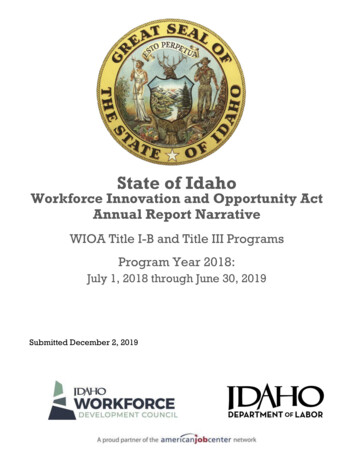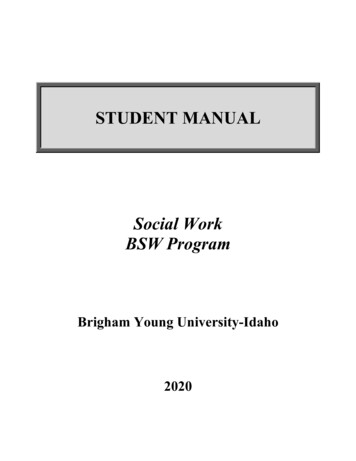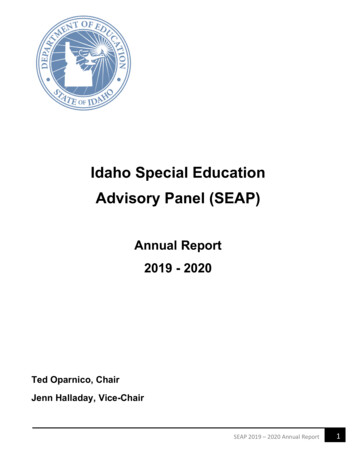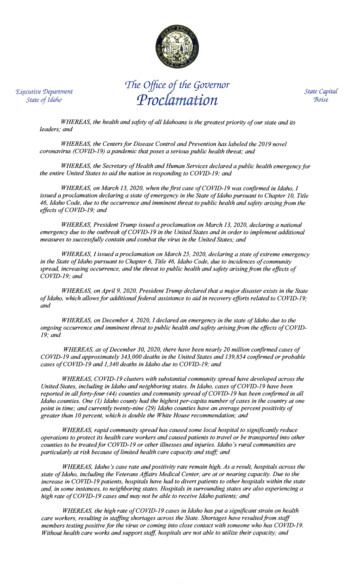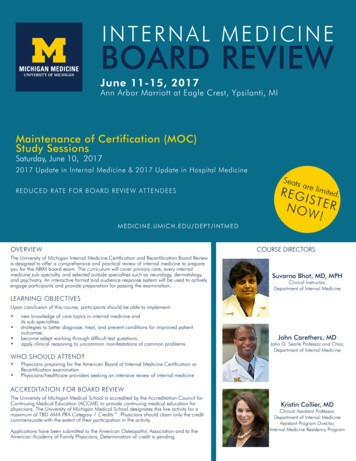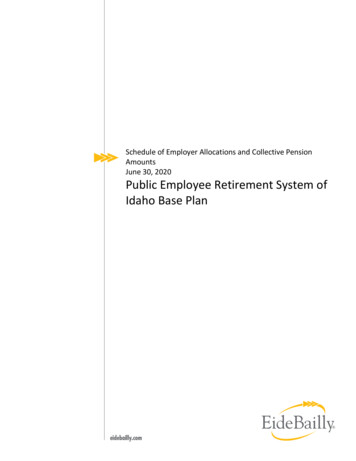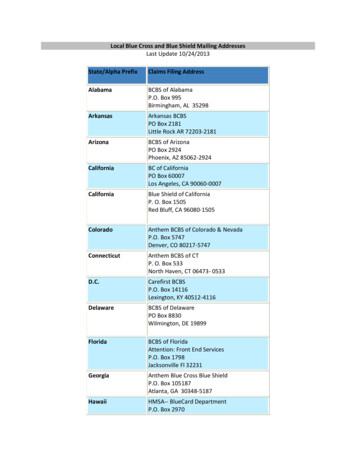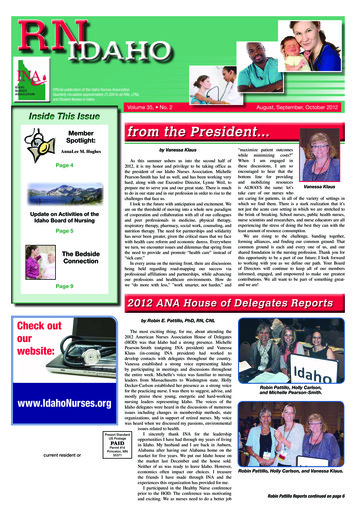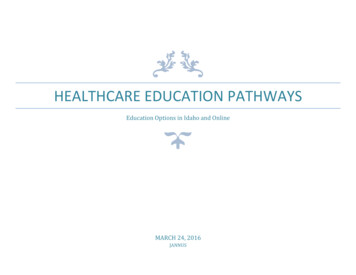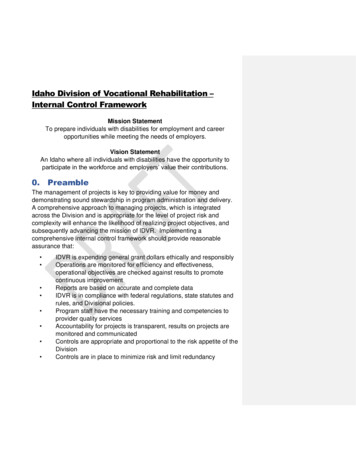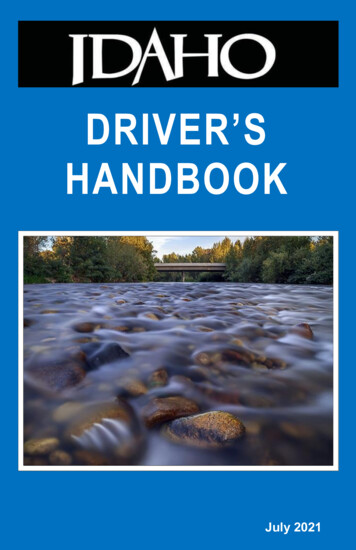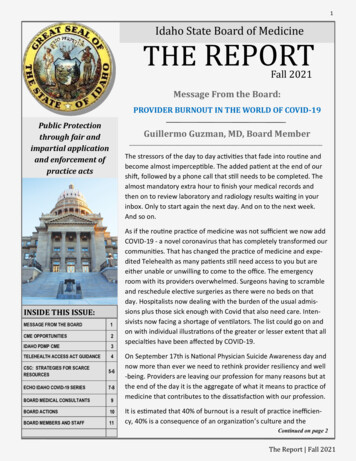
Transcription
1Idaho State Board of MedicineTHE REPORTFall 2021Message From the Board:PROVIDER BURNOUT IN THE WORLD OF COVID-19Public Protectionthrough fair andimpartial applicationand enforcement ofpractice actsGuillermo Guzman, MD, Board MemberThe stressors of the day to day activities that fade into routine andbecome almost imperceptible. The added patient at the end of ourshift, followed by a phone call that still needs to be completed. Thealmost mandatory extra hour to finish your medical records andthen on to review laboratory and radiology results waiting in yourinbox. Only to start again the next day. And on to the next week.And so on.INSIDE THIS ISSUE:MESSAGE FROM THE BOARD1CME OPPORTUNITIES2IDAHO PDMP CME3TELEHEALTH ACCESS ACT GUIDANCE4CSC: STRATEGIES FOR SCARCERESOURCES5-6ECHO IDAHO COVID-19 SERIES7-8BOARD MEDICAL CONSULTANTS9BOARD ACTIONS10BOARD MEMBERS AND STAFF11As if the routine practice of medicine was not sufficient we now addCOVID-19 - a novel coronavirus that has completely transformed ourcommunities. That has changed the practice of medicine and expedited Telehealth as many patients still need access to you but areeither unable or unwilling to come to the office. The emergencyroom with its providers overwhelmed. Surgeons having to scrambleand reschedule elective surgeries as there were no beds on thatday. Hospitalists now dealing with the burden of the usual admissions plus those sick enough with Covid that also need care. Intensivists now facing a shortage of ventilators. The list could go on andon with individual illustrations of the greater or lesser extent that allspecialties have been affected by COVID-19.On September 17th is National Physician Suicide Awareness day andnow more than ever we need to rethink provider resiliency and well-being. Providers are leaving our profession for many reasons but atthe end of the day it is the aggregate of what it means to practice ofmedicine that contributes to the dissatisfaction with our profession.It is estimated that 40% of burnout is a result of practice inefficiency, 40% is a consequence of an organization’s culture and theContinued on page 2The Report Fall 2021
2ContinuedfromfrompageContinuedpage1 3remaining 20% is a direct result of a personal inability as health care providers to stay resilient.Hospital systems are now coming to terms with the above statistics and are creating provider well-beingdepartments that are rethinking the practice of medicine in order to enable us to care for our patientsin a humane way for years to come. Medical societies are also refocusing their energies to help us remain resilient by creating awareness. On our part as providers, we have an obligation to stay healthy,both in mind and in spirit. To seek medical care when needed to be able to continue to provide for ourpatients. To seek counseling when appropriate to allows us to provide quality care. To truly rest whenaway from your work and dedicate our time also to our family and friends.Most providers experiencing burnout do offer advance warning of personal struggles in their practicesand, just as we care for our patients, so should we care for our colleagues by helping them seek the carethey need. It is important that we become familiar with our local resources by contacting local and/orstate medical societies. Additionally, employer Human Resources departments are excellent resources.Medicine can be very rewarding, and we should not forget why we chose health care as a profession.“The function of man is to live, not to exist”-Jack LondonThe Board of Medicine conductsrandom CME audits! If you are selected, be prepared to provide documentation.Idaho Prescription Drug Monitoring ProgramThe Idaho Board of [Medicine, Pharmacy] in conjunction with the Idaho Departmentof Health and Welfare, the Idaho Board of [Medicine, Pharmacy], and the IdahoBoard of Dentistry have developed a course, "Opioid Prescribing Guidelines andUse Of the Idaho Prescription Drug Monitoring Program" to provide tips on utilizingthe Idaho PDMP and implementing the CDC Guideline for Prescribing Opioids forChronic Pain into your practice. See the following pages for more information.Course completion will result in one (1) continuing education credit.To access this course, please click HERE.The Report Fall 2021
3Title: Opioid Prescribing Guidelines and Use of the Idaho Prescription Drug Monitoring ProgramOriginal Release Date: September 1, 2018Review Date: September 1, 2020Re-release Date: June 1, 2021Expiration Date: May 31, 2023Target AudienceThis learning activity is designed for Idaho health care prescribers.Educational ObjectivesUpon completion of this educational activity, participants should be able to:1. Describe the opioid epidemic within the state of Idaho.2. Integrate CDC’s Guideline for Prescribing Opioids for Chronic Pain within provider practices.3. Create and interpret PDMP data reports.4. Utilize patient prescription history to inform clinical decision-making.Identify the warning signs of medication misuse in patients.AccreditationThis activity has been planned and implemented in accordance with the accreditation requirements and policies of theAccreditation Council for Continuing Medical Education (ACCME) through the joint providership of the Federation ofState Medical Boards, the Idaho State Board of Medicine and the Idaho Department of Health and Welfare. The Federation of State Medical Boards is accredited by the ACCME to provide continuing medical education for physicians.Credit DesignationThe Federation of State Medical Boards designates this enduring material for a maximum of 1.0 AMA PRA Category 1Credit . Physicians should claim only the credit commensurate with the extent of their participation in the activity.The Federation of State Medical Boards certifies that non-physicians will receive a participation certificate stating thatthey participated in the enduring material that was designated for 1.0 AMA PRA Category 1 Credit .Course Director & PresenterMagni Hamso, MD, MPHMedical Director, Idaho Department of Health and Welfare, Division of MedicaidStaff Physician, Boise VA Medical CenterDr. Hamso is an Associate Program Director and a Clinical Assistant Professor at the University of Washington BoiseInternal Medicine Residency Program (BIMR) based at the Boise Veteran Affairs Medical Center (BVAMC) and a primary care physician at Terry Reilly Health Services (TRHS), a federally-qualified health center in Boise, Idaho. She wasborn in Norway and split her childhood between Norway and the DC-area, before attending college at Yale Universityand medical and public health school at Columbia University. She completed her residency and chief residency atMontefiore/Einstein’s Primary Care and Social Internal Medicine Residency Program in the Bronx, New York.Commercial SupportThis learning activity is not funded by any commercial entity.Disclosure of Commercial InterestAs an organization accredited by the ACCME, the Federation of State Medical Boards (FSMB) requires that the contentof CME activities and related materials provide balance, independence, objectivity, and scientific rigor. Planning mustbe free of the influence or control of a commercial entity and promote improvements or quality in healthcare.Continued on page 4The Report Fall 2021
4Continued from page 3All persons in the position to control the content of an education activity are required to disclose all relevant financialrelationships in any amount occurring within the past 12 months with any entity producing, marketing, re-selling, ordistributing health care goods or services consumed by, or used on patients.The ACCME defines “relevant financial relationships” as financial relationships in any amount occurring within the past 12 monthsthat create a conflict of interest. The FSMB has implemented a mechanism to identify and resolve all conflicts of interest prior tothe activity. The intent of this policy is to identify potential conflicts of interest so participants can form their ownjudgments with full disclosure of the facts. Participants will be asked to evaluate whether the speaker’s outside interests reflect a possible bias in the planning or presentation of the activity.The speaker, course director and planners at the Federation of State Medical Boards, the Idaho State Board of Medicine and the Idaho Department of Health and Welfare have no relevant financial interests to disclose.Disclosure of Unlabeled UsesThis educational activity may contain discussion of published and/or investigational uses of agents that are not approved by the U.S. Food and Drug Administration. For additional information about approved uses, including approved indications, contraindications, and warnings, please refer to the prescribing information for each product, orconsult the Physicians’ Desk Reference.Faculty and Staff DisclosuresIdaho Telehealth Access Act COVID-19 GuidanceThe state of Idaho is under a declaration of emergency due to the ongoing occurrence and imminent threat to publichealth and safety arising from the effects of COVID-19. Pursuant to the emergency, the Division of Occupational andProfessional Licenses (DOPL) will assist the current status of healthcare professional capacity by exercising enforcement discretion to provisions of the Telehealth Access Act to restore allowances from 2020. Any healthcare professional may provide telehealth services in or into Idaho, so long as the healthcare professional is licensed or registeredand in good standing with another U.S. state or jurisdiction and acting in good faith.A healthcare professional providing telehealth services will consider the following provisions prior to providing patientcare: A healthcare professional providing telehealth services in or into Idaho must be licensed or registered in any U.S.state or jurisdiction, and in good standing with no active or pending disciplinary action; A healthcare professional providing telehealth services in or into Idaho must act in good faith, exercise reasonablecare, and follow applicable federal regulations; A healthcare professional providing telehealth services in or into Idaho must possess the necessary education,training, and experience for the services being provided; and A healthcare professional providing telehealth services in or into Idaho must use sufficient technology to establisha patient-provider relationship for the services being provided.The Division enforcement discretion ends with the termination of the state of Idaho declaration of emergency unlessended sooner by DOPL announcement.Issued: September 9, 2021The Report Fall 2021
5Crisis Standards of Care: Strategies for Scarce Resource SituationsOn September 16, 2021, the Idaho Department of Health and Welfare activated Crisis Standards of Care (CSC) statewide in Idahobecause of the recent surge in new COVID-19 cases. CSC was activated on September 7 for the Panhandle and North Centralhealth districts and the rest of the state followed after more hospitals reported insufficient resources to provide the standard level of care to patients.CSC is a plan developed to provide a framework health systems can use to prioritize patients in order to achieve the best outcomes during a crisis. The plan contains strategies to maximize resources in five areas: Emergency Management and Public Safety,Emergency Medical Services (EMS) Hospital, Public Health, and Out of Hospital Care. As part of this plan, the Idaho Department ofHealth and Welfare adapted and modified a guidance document intended to provide recommendations for the expansion of capacity and the allocation of scarce resources during a public health emergency. The guide includes protocols focused on “ savingthe most lives and life years, within the context of ensuring meaningful access for all patients, ensuring individualized patient assessments, and diminishing the negative effects of social inequalities that lessen some patients’ long-term life expectancy.”One section of the aforementioned guide that is particularly relevant to the current COVID-19 crisis is the recommended guidancefor the triage of mechanical ventilation. This triage protocol involves the determination of a patient’s Sequential Organ FailureAssessment (SOFA) score and determination of life-limiting comorbidities, in order to determine a patient’s Priority Score andPriority Category for ventilator access. The protocol is to be followed in order and step by step:MECHANICAL VENTILATION – STRATEGIES FOR SCARCE RESOURCE SITUATIONSSTEP 1: Evaluate the patient’s clinical indication for scarce life-saving resources.Triage to Non-Critical CareAdvance directive requesting non-critical care interventions onlyCardiac arrest for which survival is unlikely: unwitnessed arrest, recurrent arrest without hemodynamic stability, arrestunresponsive to standard interventions and measures.Severe trauma: traumatic brain injury with no motor response to painful stimulus (i.e. best motor response 1 onGlasgow Coma Scale), trauma-related arrest, or severe burn where predicted survival 10% even with unlimitedaggressive therapy.Any other conditions resulting in immediate or near-immediate mortality even with aggressive therapy.STEP 2: Use the Sequential Organ Failure Assessment (SOFA) score to determine the patient’s prognosis for hospital survival.Sequential Organ Failure Assessment - SOFA ScoreORGAN TIC Bilirubin(mg/dl)CARDIOVASCULARHypotensionCENTRAL NERVOUSSYSTEMGlasgow Coma ScaleRENALCreatinineScore 01234Score 0-4 400 400 300 200 100 150 150 100 50 20 1.21.2 - 1.92.0 - 5.96 - 11.9 12NoneMean ArterialPressure 70mmHgDopamine 5or anyDobutamineDopamine 5 orEpi 0.1 or NorEpi 0.1Dopamine 15 orEpi 0.1 or Nor-Epi 0.11513 - 1410 - 126-9 6 121.2 - 1.92.0 - 3.43.5 - 4.9 5.0TOTAL SCORE 0-24Continued on page 6The Report Fall 2021
6Continued from page 5STEP 3: Using the chart below, determine the patient’s priority score based on their SOFA score (1 to 4 points, depending on severity) plus the presence or absence of comorbid conditions that may impact their near-term survival. Add the points from thefirst line of the table (Save the most lives) to the points from the second line of the table (Save life-years) to obtain a PriorityScore. Lower scores indicate a higher likelihood of benefiting from critical care.PrincipleSave themost livesSave lifeyearsSpecificationPrognosis forsurvival to hospitaldischarge - SOFAScorePrognosis for nearterm survival(medicalassessement ofcomorbidities)12SOFA score 6SOFA score6-8No points addedPOINT SYSTEM3SOFA score9-11Major comorbiditieswith substantialimpact on near-termsurvivalADD 2 POINTSNo points added4SOFA score12 Severe, life-limitingcomorbidities for whichdeath is expected in thenear-term despitesuccessful treatment ofacute illness (e.g., meetshospice criteria)ADD 4 POINTSSTEP 4: Assign the patient, whether adult or pediatric, to a Priority Category, based on their Priority Score. Prioritize patients inthe “Red” category for ventilator access first, then patients in the “Orange” category, then patients in the “Yellow” category.Use Raw Score from Step 3 to Assign Priority CategoryLevel of Priority and Code ColorPriority from Step 3 Scoring SystemREDPriority Score1-3Highest PriorityORANGEIntermediate Priority(reassess as needed)YELLOWLowest Priority(reassess as needed)Priority Score4-5Priority Score6-8As stated in the ethical goal of the mechanical ventilation allocation framework shown in part above, a local Triage team separatefrom the patient’s treatment team would determine ventilator allocation using the recommended steps. The framework alsocontains guidance for pediatric patients and for resolving “ties,” in the event that multiple patients in the same Priority Categoryneed access to the same ventilator.The tables shown above are for illustrative purposes only and do not represent this framework in its entirety. To see the entiremechanical ventilation allocation protocol and all other guidance recommendations, please see the document in its entirety athttps://coronavirus.idaho.gov/idaho-resources/.- Jason Weaver, Medical Investigator, Idaho State Board of MedicineThe Report Fall 2021
7The Report Fall 2021
8COVID-19 Program StructureEach session provides participants with an update andinterpretation of COVID-19 numbers nationally and inIdaho, an opportunity to ask questions about diagnosisand treatment of coronavirus through a case review andhelp identifying helpful resources – whether that berelated to administration or clinical practice.TENTATIVE SESSION TOPICS INCLUDE:The Delta VariantVaccine HesitancyLong-COVIDBehavioral Health Ramifications for Patients andProvidersCOVID-19MEET OUR TEAMSky Blue, MDInfectious Disease Medicine,Sawtooth Epidemiology andInfectious DiseasePaula Carvalho, MDIntensivist: Pulmonary Disease,Critical Care and PalliativeMedicine, Boise VA MedicalCenterMeg Dunay, MD, MPHGeriatrics and Palliative CarePhysician, Idaho State Veterans’HomeBoostersCOVID-19 in Pediatric and Geriatric CareAnn Lima, MD, MPHCOVID-19 Impact on Opioid and Drug Use in IdahoRural Family Physician,Clearwater Valley Hospital andClinics, OrofinoPreparing to Re-Open: Back-To-School and BackTo-WorkLearn more and sign up for ECHO Idaho atwww.uidaho.edu/echoCathy Oliphant, PharmDPharmacist, Professor and CoChair, ISU College of PharmacyIf you miss a session, recordings are availableon the website.Questions? Contact us atechoidaho@uidaho.edu or 208-364-4640.Text @echoID to 81010 to sign up for textreminders.Amy Walters, PhDHealth Psychologist and Directorof Behavioral Health Services,St. Luke’s Humphrey’s DiabetesCenterThe University of Idaho, WWAMI Medical Education Program is accreditedby the Accreditation Council for Continuing Medical Education (ACCME) toprovide continuing medical education for physicians.The University of Idaho, WWAMI Medical Education Program designateseach live activity for a maximum of 1.0 AMA PRA Category 1 Credits .Physicians should claim only the credit commensurate with the extent oftheir participation in the activity.The Report Fall 2021
9Medical Consultants to the BoardThe Idaho Board of Medicine is responsible for investigating and, when appropriate, conducting disciplinary actions against physicians for violations of theIdaho Medical Practice Act. The Board fulfills its statutory responsibility by investigating complaints, reports of malpractice payments, changes in staff privileges, disciplinary actions by other state medicalboards, and other reports that come to its attention.Complaints and other types of investigations, alongwith supporting materials, including the physician'sresponse to the allegations and medical records, arefirst reviewed by the Board investigators and a summary of the findings is presented to the Board for itto determine if further investigation or expert reviewis warranted. Only a relatively small portion of casesreceived by the Board are sent for expert review.The Board uses qualified medical consultants to determine whether the accepted standard of care hasbeen met. The Board will ask for a consultant for avariety of reasons. The Board may simply need additional information and an opinion about a case nototherwise available.some specialties or areas of practice may be askedmore frequently than others to perform a review.The Board needs medical consultants in all areas ofpractice, but the frequency with which consultantsare asked to perform reviews is variable and dependson multiple factors. Being a medical consultant is notthe same as being asked to provide testimony as anexpert witness on community standard during a prelitigation hearing panel.If the Board determines that discipline action is indicated, and no agreement with the physician regarding discipline action can be reached, a hearing maybe scheduled and a consultant would be asked toprovide expert testimony. The majority of cases aresettled without going to a hearing.Medical consultants to the Board must be Board Certified and recently retired from or currently in a clinical practice similar to the named provider. In addition, medical consultants to the Board must be freefrom current Board disciplinary review.Consultants to the Board are reimbursed at a rate of 150 per hour for a medical record case review andSubmitting a case for review does not necessarily im- completion of a report containing a summary of findply there were departures from the standard of care. ings.A reviewer for the Board is neither an advocate forIf you hold an unrestricted Idaho medical license andthe Board nor an advocate for the physician.are interested in joining the Board’s pool of indeThere are some specialties that come to the Board'spendently contracted medical consultants, pleaseattention more frequently than others, such as painemail info@bom.idaho.gov for more information.management. As a result, medical consultants inBOARD OF MEDICINE FACEBOOK PAGEThe Board of Medicine is now on social media. Find us on Facebook andgive us a like for the latest updates from the Board.Find us on Facebook!The Report Fall 2021
10Board ActionsExplanation of TermsThe following are nonreportable, non-disciplinaryactions:· Letter of Concern: nondisciplinary letter issuedfor a minor violation theBoard feels may pose a riskto public safety.· Corrective Action Plan:confidential, nonreportable practiceremediation.Carroll, Ronald E., M.D. (M-4116), Payette, IDLicensee failed to adequately fulfill his responsibilities as a supervising physician as required by his delegation of servicesagreement, statute and board rule. He signed a stipulation andorder agreeing to not supervise or collaborate with a physicianassistant for a period of two years.Lu, Kang, M.D. (M-11662), Crestview, FLLicensee’s Idaho medical license was revoked reciprocal to anorder for revocation issued by the Commonwealth of Massachusetts Board of Registration in medicine.· Fine: a fee imposed forfailure to provide accurateinformation on renewal.The following are reportabledisciplinary actions:· Stipulation and Order(S&O): an agreementbetween the Board and thepractitioner regardingauthorization to practice orplacing terms or conditionson the authorization topractice.· Public Reprimand: a formaladmonishment of conductor practice.· Suspension: temporarywithdrawal ofauthorization to practice.· Revocation: cancellation ofthe authorization topractice.· Administrative Complaint:occurs when a licenseerefuses to sign arecommended stipulation.Commences formaladministrative disciplinaryhearing process.The Report Fall 2021
11IDAHO STATE BOARD OF MEDICINEDavid McClusky III, MD, ChairmanCatherine Cunagin, MD, Vice ChairmanKeith Davis, MD, MemberMark Grajcar, DO, MemberGuillermo Guzman, MD, MemberIdaho State Board Of MedicinePaula Phelps, PA, MemberKed Wills, ISP, MemberLogger Creek Plaza345 Bobwhite Court, Suite 150Boise, Idaho 83706Phone: 208-327-7000Fax: 208-327-7005E-mail: info@bom.idaho.govMichele Chadwick, Public MemberCOMMITTEE ON PROFESSIONAL DISCIPLINEWilliam H. Miller, MD, ChairmanMichelle Ebbers, MD, MemberAmy Laurel Cooper, MD, MemberLarry T. Curtis, MD, MemberVisit our Website at:Robert Yoshida, Public Memberwww.bom.idaho.govNaturopathic Medical BoardBoard StaffJoan Haynes, NMD (Chair)Nicole Marie Maxwell, NMDCory Szybala, NMDNicki Chopski, Executive OfficerTaralyn Erbele, MDYvonne Dunbar, Board AttorneyKelsey Jae, JD, Public MemberPhysician Assistant AdvisoryCommitteeDiane Griffitts, Business AnalystBoard of Athletic TrainersFrutoso Gonzalez, Medical InvestigatorJason Weaver, Medical InvestigatorRichard Bingham, AT (Chair)Debbie Mitchell, Medical InvestigatorMary Eggleston Thompson, PA (Chair)Dani Michelle Moffit, ATHeather M. Frazee Whitson, PAAlta Graham, Public MemberHelen Kuo, Medical InvestigatorAnntara Smith, PAElisha Fawkes, Licensing SpecialistErin Sue Carver, PAValentin Roy Garcia, Public MemberDietetic Licensure BoardRespiratory TherapyLicensure BoardSuzanne Marguerite Linja, LD (Chair)Michelle Jarvis, Public Member(Chair)Katie Rebecca Miner, LDCarla Ellen Miller, RT, RPSGTPamela Howland, Public MemberCarol Fellows Kirkpatrick, PhDFelicia Kruck, Investigations SpecialistLutana Holloway Haan, RTPhillip Hager, RTJodi Adcock, Licensing SpecialistLinda Holt, Licensing SpecialistClaudia Lawson, Licensing SpecialistSai Ellis, Licensing SpecialistJennifer Woodland, Prelitigation SpecialistCindy Fosella, ReceptionThe Report Fall 2021
Sep 01, 2018 · The Idaho Board of [Medicine, Pharmacy] in conjunction with the Idaho Department of Health and Welfare, the Idaho Board of [Medicine, Pharmacy], and the Idaho Board of Dentistry have developed a course, "Opioid Prescribing Guidelines and Use Of the Idaho Prescript
